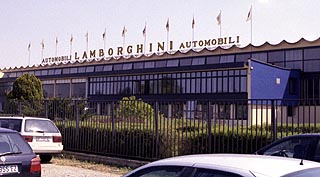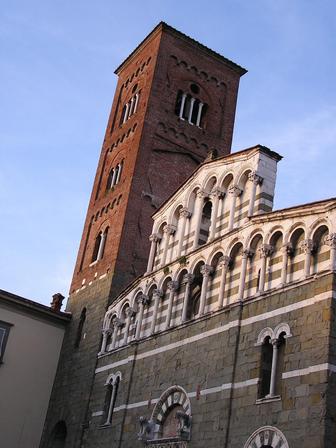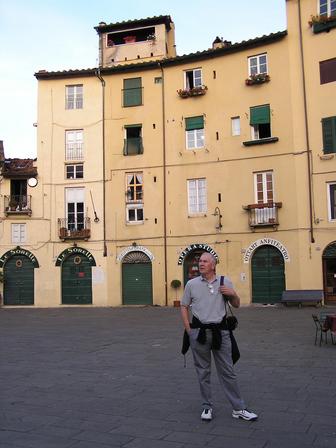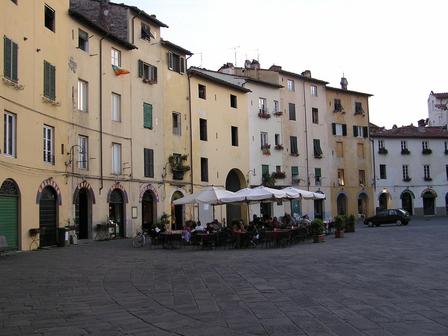Eight Day
We got up at 8:00, had breakfast and headed toward Lucca. Getting out of Venice was very hectic....We have just learned how crazy it is to drive in Italy. It was quite impossible to drive on regular roads and get somewhere. The roads go through every little town, and are full of stop signs and traffic lights. Italians do not care much for traffic regulations. Red lights are merely a suggestion for them. However we took this day easy, and were wandering around in Tuscany. We knew we had to get to Lucca for our student hostel before 3 p.m.
http://www.big-italy-map.co.uk/map-of-veneto-map.htm
We stopped in Ferrara, where we walked around and had lunch .

http://goeurope.about.com/library/phot/bl_ferrara_5.htm
As we were cruising further toward Lucca, we accidentally drove by a

http://www.lamborghiniregistry.com/Factory/
This factory has a company museum
on the grounds, which houses many special cars including the last made
of several models and several Formula 1 cars. We were very unlucky,
because the museum were closed, and we could not find anyone to open it
for us.
Late afternoon we arrived to Lucca.
 On
the left is the map of Lucca. The old city center is impossible to drive
in. We made the mistake to try to do just that, and it took us about an
hour to try to get out, and not to hit anybody. Today Allen's handicap
sticker was really helpful, because parking in Lucca might be worse than
driving.
On
the left is the map of Lucca. The old city center is impossible to drive
in. We made the mistake to try to do just that, and it took us about an
hour to try to get out, and not to hit anybody. Today Allen's handicap
sticker was really helpful, because parking in Lucca might be worse than
driving.
Below is the picture of Lucca

(http://www.italy-accomodation.com/immagini/lucca.rex.gif) (www.realitaly.com/ lucca/onceupon.html)
The first historical traces of Lucca can be dated back
to the Palaeolithic period. Afterwards this area was inhabited by the
Ligurians, the Etruscans and in the III century by the Romans. In 180
B.C. it became a Latin colony. This was a period of splendour for the
town because of its strategic position: the most important roads of the
time, such as the Cassia, the Aurelia and the Clodia, intersected just
outside the town.
The geometrical layout of the town and the Roman Forum can be dated back
to this period.
During the barbaric domination Lucca was the capital of the Longobard
reign until the IX century.
It became a free Comune in 1162 and in the following centuries it
knew a new period of riches and splendour thanks to its banking and
manufacturing activities and its trades with the rest of Europe and the
East. A lot of beautiful and luxury buildings and towers are still today
a sign of the prosperity the town enjoyed in that period.
In the first half of the XV century Lucca was ruled by Paolo Guinigi who
improved its art and architecture: he had some important works made,
such as Palazzo Guinigi and the wonderful sarcophagus of his wife,
Ilaria del Carretto, which was made by Jacopo della Quercia.
In the XV and XVI centuries the town fought to maintain its indipendence
from the nearby powerful Firenze, so new and stronger town walls were
erected. The town changed its urban shape completely, as some old
buildings and towers were replaced by new stately mansions with towers
along the most important streets of the town.
In 1799 Lucca underwent the Napoleon rule which lasted for 12 years. The
town was ruled by Napoleon’s sister Elisa, wife of Felice Baciocchi.
They lived in the Palazzo Pubblico in front of which a large square was
opened: Piazza Napoleone.
After the Congress of Vienna in 1814, Lucca began to be ruled by Parma.
In this period the architect Lorenzo Nottolini planned the squares and
the quarters of the town and created the picturesque promenade along the
town walls.
When in 1847 Lucca became part of the Grand Duchy of Toscana, a period
of decay started for the town and ended only with the annexation to the
Reign of Italy. (www.realitaly.com/
lucca/onceupon.html)




We had dinner at this restaurant. Had a very pleasant time, we even listened for some music played by the girl in the picture above. She had a sweet voice, and was singing well known Italian songs.
After dinner we went to the famous city walls and actually walked on top of one of them.
(www.uwgb.edu/galta/ 333/Tuscany/page_04.htm)